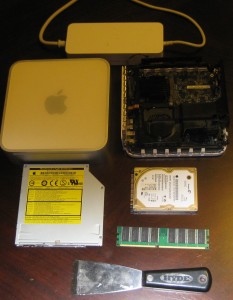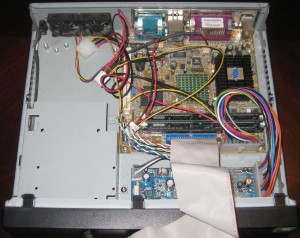I recently sent a few old machines off for recycling. Both had relevance to the early days of the FATE testing effort. As is my custom, I photographed them (poorly, of course).
First, there’s the PowerPC-based Mac Mini I procured thanks to a Craigslist ad in late 2006. I had plans to develop automated FFmpeg building and testing and was already looking ahead toward testing multiple CPU architectures. Again, this was 2006 and PowerPC wasn’t completely on the outs yet– although Apple’s MacTel transition was in full swing, the entire new generation of video game consoles was based on PowerPC.
I remember trying to find a Mac Mini PPC on Craigslist. Many were to be found, but all asked more than the price of even a new Mac Mini Intel, always because the seller was leaving all of last year’s applications and perhaps including a monitor, neither of which I needed. Fortunately, I found this bare Mac Mini. Also fortunate was the fact that it was far easier to install Linux on it than the first PowerPC machine I owned.
After FATE operation transitioned away from me, I still kept the machine in service as an edge server and automated backup machine. That is, until the hard drive failed on reboot one day. Thus, when it was finally time to recycle the computer, I felt it necessary to disassemble the machine and remove the hard drive for possible salvage and then for destruction.
If you’ve ever attempted to upgrade or otherwise service this style of Mac Mini, you will no doubt recognize the pictured paint scraper tool as standard kit. I have had that tool since I first endeavored to upgrade the RAM to 1 GB from the standard 1/2 GB. Performing such activities on a Mac Mini is tedious, but only if you care about putting it back together afterwards.
The next machine is a bit older. I put it together nearly a decade ago, early in 2005. This machine’s original duty was “download agent”– this would be more specifically called a BitTorrent machine in modern tech parlance. Back then, I placed it on someone else’s woefully underutilized home broadband connection (with their permission, of course) when I was too cheap to upgrade from dialup.
This is a small form factor system from VIA that was clearly designed with home theater PC (HTPC) use cases in mind. It has a VIA C3 x86-compatible CPU (according to my notes, Centaur VIA Samuel 2 stepping 03, flags: fpu de tsc msr cx8 mtrr pge mmx 3dnow) and 128 MB of RAM (initially; I upgraded it to 512 MB some years later, just for the sake of doing it). And then there was the 120 GB PATA HD for all that downloaded goodness.
I have specific memories of a time when my main computer at home wasn’t working correctly for one reason or another. Instead, I logged into this machine remotely via SSH to make several optimizations and fixes on FFmpeg’s VP3/Theora video decoder, all from the terminal, without being able to see the decoded images with my own eyes (which is why I insist that even blind people could work on video codecs).
By the time I got my own broadband, I had become inspired to attempt the automated build and test system for FFmpeg. This was the machine I used for prototyping early brainstorms of FATE. By the time I put a basic build/test system into place in early 2008, I had much faster computers that could build and test the project– obvious limitation of this machine is that it could take at least 1/2 hour to build the entire codebase, and that was the project from 8 years ago.
So the machine got stuffed in a closet somewhere along the line. The next time I pulled it out was in 2010 when I wanted to toy with Dreamcast programming once more (the machine appears in one of the photos in this post). This was the only machine I still owned which still had an RS-232 serial port (I didn’t know much about USB serial converters yet), plus it still had a bunch of pre-compiled DC homebrew binaries (I was having trouble getting the toolchain to work right).
The next time I dusted off this machine was late last year when I was trying some experiments with the Microsoft Xbox’s IDE drive (a photo in that post also shows the machine; this thing shows up a lot on this blog). The VIA machine was the only machine I still owned which had 40-pin IDE connectors which was crucial to my experiment.
At this point, I was trying to make the machine more useful which meant replacing the ancient Gentoo Linux distribution as well as simply interacting with it via a keyboard and mouse. I have a long Evernote entry documenting a comedy of errors revolving around this little box. The interaction troubles were due to the fact that I didn’t have any PS/2 keyboards left and I couldn’t make a USB keyboard work with it. Diego was able to explain that I needed to flip a bit in the BIOS to address this which worked. As for upgrading the OS, I tried numerous Linux distributions large and small, mostly focusing on the small. None worked. I eventually learned that, while I was trying to use i686 distributions, this machine did not actually qualify as an i686 CPU; installations usually booted but failed because the default kernel required the cmov instruction. I was advised to try i386 distros instead. My notes don’t indicate whether I had any luck on this front before I gave up and moved on.
I just made the connection that this VIA machine has two 40-pin IDE connectors which means that the thing was technically capable of supporting up to 4 IDE devices. Obviously, the computer couldn’t really accommodate that in terms of space or power. When I wanted to try installing a new OS, I needed take off the top and connect a rather bulky IDE CD-ROM drive. This computer’s casing was supposed to be able to support a slimline optical drive (perhaps like the type found in laptops), but I could never quite visualize how that was supposed to work, space-wise. When I disassembled the PowerPC Mac Mini, I realized I might be able to repurpose that machines optical drive for this computer. Obviously, I thought better of trying since both machines are off to the recycle pile.
I would still like to work on the Xbox project a bit more, but I procured a different, unused, much more powerful yet still old computer that has a motherboard with 1 PATA connector in addition to 6 SATA connectors. If I ever get around to toying with Linux kernel development, this should be a much more appropriate platform to use.
I thought about turning this machine into an old Windows XP (and lower, down to Windows 3.1) gaming platform; the capabilities of the machine would probably be perfect for a huge portion of my Windows game collection. But I think the lack of an optical drive renders this idea intractable. External USB drives are likely out of the question since there is very little chance that this motherboard featured USB 2.0 (the specs don’t mention 2.0, so the USB ports are probably 1.1).
So it is with fond memories that I send off both machines, sans hard drives, to the recycle pile. I’m still deciding on an appropriate course of action for failed hard drives, though.



I used my MacMini for development till maybe 2009 and couple of years more for web browsing (just imagine that 512 MB RAM was enough for a browser!). Nowadays there are enough ARM boxes for making a small quiet server.
As for games — I remember the period when I preferred Windows games because they were less hassle to run than DOS games (if you ever needed more than 600k conventional RAM you’d understand me) but since DOSBox it’s much easier to emulate them than to run games intended for Win95-98 and refusing to run on something newer. That’s when I miss my first PII-based laptop.
Funny you post about recycling this, when I /just/ got my hands on one. :p I realize I’m late to the party, and any skills I get with PowerPC won’t be terribly applicable. I just upgraded the RAM from 512MB to 1GB, was planning on picking up an OWC SSD soon.
“That is, until the hard drive failed on reboot one day.” So was it the hard drive or the machine that had the problem? You said you’re recycling the machine but keeping the HDD. What would be wrong with the computer that it couldn’t boot from HDD? I was hoping the one I picked up would last a while, but I’m not terribly familiar with Apple hardware.
@Brian: I’m pretty sure the HDD was at fault with the Mac Mini. Maybe some bad sectors prevented the reboot. It was many months later that I got around to disassembling the thing the remove the HDD. When I used a special IDE-to-USB adapter, I wasn’t able to get another Linux box to recognize the partition table.
The machine probably could have been useful with another (laptop IDE interface) HDD. However, that would have meant being prepared to reassemble the machine, which I didn’t care to do. Plus, I wouldn’t know how to install a new OS– the optical drive on this thing has been flaky and mostly useless for most of the time I owned it. So I would have had to replace that as well. I was never able to get something to boot from a USB drive on here.